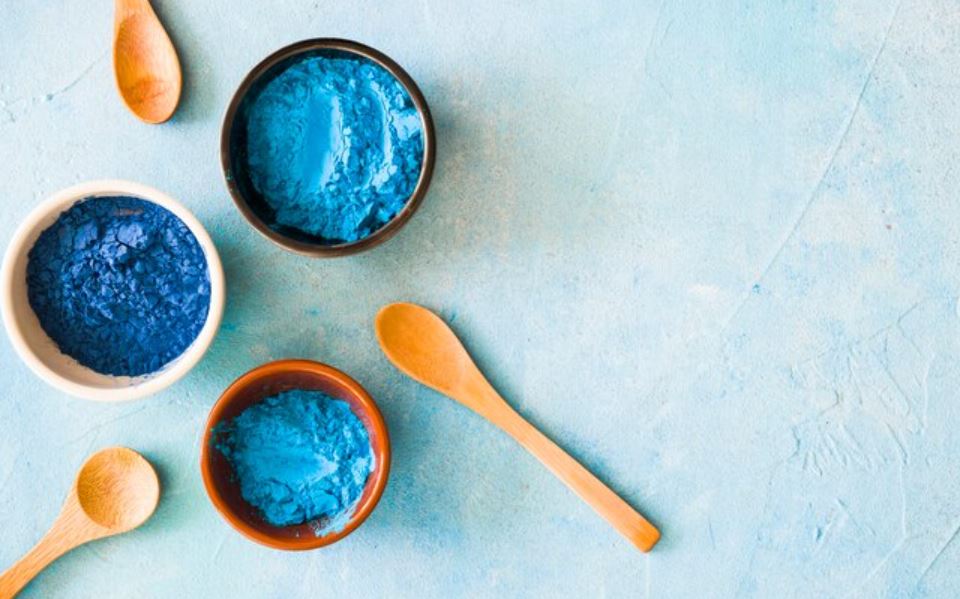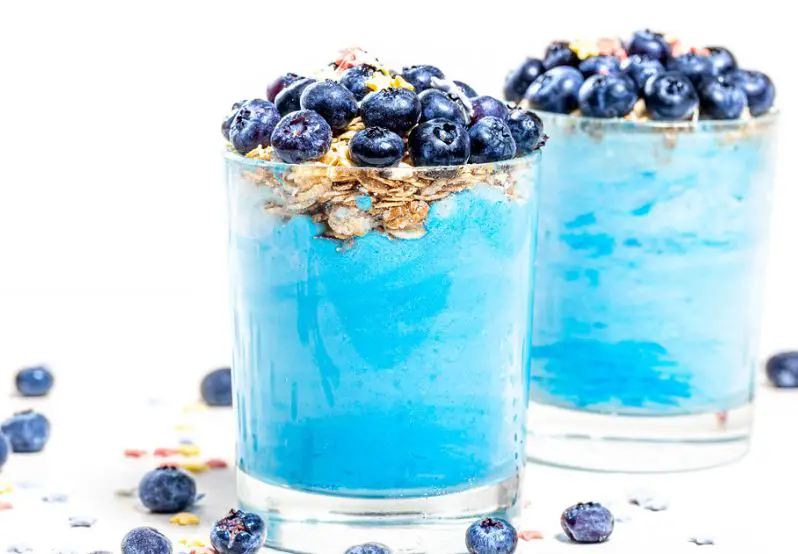Introduction
Blue Spirulina, a vibrant and nutrient-rich superfood, is gaining popularity for its health benefits and striking color. Derived from blue-green algae, it’s a natural source of vitamins and minerals, making it a sought-after ingredient in health-conscious diets.
Definition and Overview
Blue Spirulina is a phycocyanin-rich extract from Arthrospira platensis, commonly known as Spirulina. Unlike its green counterpart, it’s free from chlorophyll, giving it a unique blue hue. This superfood is celebrated for its high protein content, antioxidants, and vitamins, including B vitamins, iron, and manganese. It’s a versatile ingredient, often used in smoothies, juices, and culinary creations for its nutritional value and vibrant color. Its growing popularity stems from its potential health benefits, including immune system support, anti-inflammatory properties, and its role in promoting heart and brain health.
Historical Background
The use of Spirulina dates back to ancient civilizations, notably the Aztecs, who harvested it from Lake Texcoco in Mexico. Blue Spirulina, however, is a more recent development, gaining attention for its concentrated nutrient profile and striking color. Its extraction process, which isolates the phycocyanin pigment, is a modern innovation. This has led to its emergence as a popular dietary supplement and a natural food coloring agent, aligning with the growing trend towards natural and health-promoting ingredients in the food industry.
Nutritional Profile of Blue Spirulina
Blue Spirulina stands out for its impressive nutritional profile. It’s not only a visual delight but also a powerhouse of health benefits, packed with essential nutrients that cater to various dietary needs.
Key Nutrients and Compounds
This superfood is a treasure trove of nutrients. It’s rich in protein, comprising about 60-70% of its dry weight, making it a fantastic plant-based protein source. Blue green algae supplement is also abundant in vitamins, particularly B12, making it a favorite among vegetarians and vegans. It contains gamma-linolenic acid, a beneficial fatty acid, along with significant amounts of iron, calcium, and antioxidants. These nutrients contribute to its anti-inflammatory and antioxidant properties, supporting overall health and well-being.
Comparison with Traditional Spirulina
While traditional green Spirulina and blue Spirulina originate from the same algae, their nutrient compositions differ slightly due to the extraction process. The Spirulina is primarily valued for its high phycocyanin content, the pigment responsible for its blue color, which is known for its antioxidant properties. In contrast, green Spirulina contains chlorophyll, which has its own health benefits. Both forms are excellent sources of nutrients, but Spirulina offers a unique combination of visual appeal and concentrated health benefits, making it a distinctive choice in the realm of superfoods.
Health Benefits of Blue Spirulina
Blue Spirulina emerges as a functional food with a myriad of health benefits, making it a valuable addition to health-conscious diets and lifestyles.
Immune System Support
A key benefit of Blue Spirulina is its robust support for the immune system. Packed with essential vitamins and minerals, it significantly enhances the body’s natural defense mechanisms. The B vitamins, in particular, are crucial in maintaining and bolstering a healthy immune response. Regular inclusion of Blue Spirulina in one’s diet can play a pivotal role in strengthening the body’s resilience against various infections and diseases, thereby promoting overall health and wellness.
Antioxidant Properties
Renowned for its potent antioxidant properties, Blue Spirulina owes much of this capability to phycocyanin, a vibrant pigment and a powerful antioxidant. This compound is instrumental in combating oxidative stress within the body, a factor often linked to chronic diseases. By effectively neutralizing harmful free radicals, Spirulina plays a significant role in protecting cells from damage and contributes to the maintenance of long-term health and vitality.
Impact on Digestive Health
Beyond its immune and antioxidant benefits, Blue Spirulina also exerts a positive influence on digestive health. As a source of dietary fiber, it promotes healthy digestion and regular bowel movements. The anti-inflammatory properties of Blue Spirulina are particularly beneficial for soothing the digestive tract, making it an advantageous supplement for individuals with sensitive stomachs or those suffering from various digestive disorders.
Blue Spirulina in Dietary Supplements
Blue Spirulina’s versatility as a dietary supplement makes it accessible in various forms, each catering to different preferences and dietary needs.
Forms and Varieties
Available predominantly in powder form, Blue Spirulina can be easily incorporated into a variety of foods, smoothies, and juices, offering a convenient way to boost nutritional intake. For those seeking a more straightforward, no-preparation-required option, it is also available in tablet or capsule form. The powdered variant provides flexibility in culinary uses, while the tablet and capsule forms are ideal for those who prioritize ease of use and precise dosage.
How to Choose Quality Supplements
Selecting high-quality Blue Spirulina supplements is crucial. It’s important to opt for products that are free from unnecessary additives, preservatives, and artificial colors. Seeking out organic certification can be a reliable indicator of a product’s quality. Additionally, choosing supplements from well-established, reputable brands that are transparent about their sourcing and manufacturing processes is advisable. This ensures that consumers receive the best quality product, maximizing the health benefits of it.
Culinary Uses of Blue Spirulina
Blue Spirulina is not only a nutritional powerhouse but also a versatile ingredient in the culinary world, adding both color and nutrition to various dishes.
Blue Spirulina in Smoothies and Beverages
One of the most popular ways to use Blue Spirulina is in smoothies and beverages. Its vibrant blue hue adds a visual pop to drinks, making them not only nutritious but also aesthetically appealing. Blue Spirulina pairs well with a range of fruits and vegetables, enhancing the nutritional value of smoothies without overpowering their taste. It’s also a great addition to healthful juices, plant-based milk, and even in creative mocktails, providing a nutrient boost along with a striking color.
Creative Cooking Ideas
Beyond beverages, Blue Spirulina can be a creative addition to various dishes. It can be used as a natural food coloring in desserts like puddings, cakes, and frostings, offering a healthier alternative to synthetic colorants. Blue green algae supplement can also be sprinkled over salads for a nutrient boost or incorporated into dressings and sauces. For a more adventurous culinary experience, it can be used in pasta doughs or as a garnish on exotic dishes, making meals not only more nutritious but also visually stunning.
Blue Spirulina and Fitness
Blue Spirulina is increasingly recognized in the fitness world for its benefits to athletes and fitness enthusiasts, offering support both before and after workouts.
Benefits for Athletes and Fitness Enthusiasts
For athletes and those dedicated to fitness, Blue Spirulina offers numerous benefits. Its high protein content aids in muscle repair and growth, making it an excellent supplement for strength training. The presence of B vitamins and iron in The Spirulina helps in improving energy levels and endurance, which is crucial for prolonged physical activities. Additionally, its anti-inflammatory properties can help reduce muscle soreness and accelerate recovery after intense workouts, making it a valuable addition to any athlete’s nutrition regimen.
Pre and Post-Workout Uses
Incorporating Blue Spirulina into pre-workout meals or drinks can provide a boost in energy and endurance. Its nutrient-rich profile supports sustained energy release, which is essential for maximizing workout performance. Post-workout, It can be beneficial in recovery. The antioxidants and anti-inflammatory compounds aid in reducing muscle soreness and fatigue, while its protein content supports muscle repair. Adding Blue Spirulina to post-workout smoothies or snacks can help in quicker recovery and better muscle growth.
Blue Spirulina for Skin and Beauty
Beyond its health and fitness benefits, Blue Spirulina is also making waves in the skin and beauty industry.
Skin Health Benefits
Blue Spirulina is rich in antioxidants, which are essential for maintaining healthy skin. These antioxidants protect the skin from oxidative damage caused by environmental factors like pollution and UV rays. The anti-inflammatory properties of Blue Spirulina can also help in reducing skin inflammation, making it beneficial for conditions like acne and eczema. Its high content of vitamins and minerals nourishes the skin, promoting a healthy, radiant complexion.
Incorporation in Beauty Products
The unique properties of Blue Spirulina have led to its incorporation in various beauty products. It is used in facial masks, creams, and serums for its nourishing and protective qualities. The vibrant blue color of Blue Spirulina also adds a natural hue to cosmetic products. In addition to its skin health benefits, Blue Spirulina is valued in the beauty industry for being a natural, plant-based ingredient, aligning with the growing trend towards clean and sustainable beauty products.
How to Incorporate Blue Spirulina in Diet
Integrating Blue Spirulina into your diet can be both beneficial and enjoyable, with various ways to include this superfood in daily meals.
Daily Recommended Intake
While there is no specific daily recommended intake for Blue Spirulina, a general guideline is to start with small amounts, such as one teaspoon per day, and observe how your body reacts. This amount can be gradually increased, depending on individual tolerance and nutritional needs. It’s important to listen to your body and adjust the intake accordingly.
Recipe Ideas
Blue Spirulina can be creatively used in a variety of recipes. Add it to your morning smoothies or oatmeal for a nutrient boost. It can also be used in baking, giving bread, pancakes, or muffins a unique color and added nutrients. For a savory twist, mix Blue Spirulina into salad dressings or sprinkle it over soups and salads. Its mild flavor makes it versatile in both sweet and savory dishes, allowing for a range of culinary explorations.
Potential Side Effects and Precautions
While Blue Spirulina is generally safe for most people, there are some potential side effects and precautions to be aware of.
Allergies and Interactions
Individuals with allergies to seafood or seaweed should be cautious, as they may also be allergic to Blue Spirulina. It’s also important to consider potential interactions with medications, particularly those affecting the immune system, as Blue Spirulina can enhance immune system activity. Consulting with a healthcare provider before starting any new supplement, including Blue Spirulina, is always recommended, especially for those with pre-existing health conditions or those taking medication.
Guidelines for Safe Consumption
To ensure safe consumption, it’s crucial to source Blue Spirulina from reputable suppliers to avoid contamination with toxins or heavy metals. Starting with a small dose and gradually increasing it can help in monitoring any adverse reactions. Staying within the recommended intake and not using Blue Spirulina as a substitute for a varied diet is also important. Pregnant or breastfeeding women should consult a healthcare professional before adding Nutrient Rich algae to their diet.



